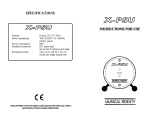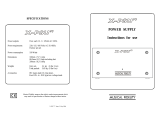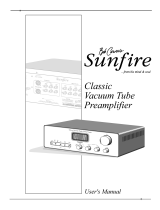
Tri-Vista Pre Instructions for Use Page 7 of 11
Issue 1: April 2003
CONNECTIONS
All connections should be made with the mains
power switched OFF.
POWER CONNECTION
Using leads supplied, connect both of the two
PSU OUTPUT sockets on the rear panel of
the power supply unit to sockets on the pre-
amplifier marked PSU INPUT. Similarly,
connect a single socket marked LV PSU
INPUT on the power supply unit to LV PSU
OUTPUT on the pre-amplifier. A further sin-
gle lead connects LV PSU OUTPUT on the
power supply to LV PSU INPUT on the pre-
amplifier.
INPUT CONNECTIONS - PHONO
Each of the two Tri-Vista Pre-amplifier mod-
ules has two phono input sockets, one for mov-
ing magnet (MM) and the other for moving
coil (MC) pickup cartridges. (See also page 9,
MM / MC switching)
Two sets of switches located on the rear panels
of each module are for optimising phono per-
formance as follow :
MC (only):
Input loading can be changed as required by
sliding the LOADING switch underneath the
PHONO MC input socket between the 100
Ohms and 10 Ohms options. Both positions
have an input capacitance of 470pF.
MM (only):
A four-way switch underneath the PHONO
MM input socket is for matching the charac-
teristics of your phono pickup and lead to the
Tri-Vista Pre. When all the switches are off
(up), the input impedance is 68K Ohms in par-
allel with 47pF.
When each individual lever is moved down-
wards, loading of the MM phono input circuit
changes as shown by adjacent graphics on the
rear panel (see also specification on page 11).
If you are not sure which combination to
select, please consult your dealer.
Some turntables or pickup arms are fitted with
an extra wire for chassis earthing. This should
be connected to the earth terminal on the lower
edge of the back panel.
AUDIO INPUT CONNECTIONS - MAIN
The Tri-Vista Pre also has five “line level”
inputs which are electrically identical, and
therefore suitable for use with any source com-
ponent having an output of at least 300mV.
The sockets on the rear panel are marked CD,
SACD, TUNER, AUXiliary, and TAPE,
corresponding with functions on the front panel
selector knob.
Using good quality RCA co-axial audio leads,
connect the left and right outputs from your CD
player, SACD player, tuner or tape deck to the
appropriate RCA input sockets on the back
panel.
PRE-AMPLIFIER OUTPUT
Each Tri-Vista Pre module has two audio out-
puts from RCA sockets on the back panel,
marked PRE-OUT 1 and 2 which are con-
trolled by the volume adjustment.
This is to allow “bi-amplification” using suit-
able separate external amplifiers and crossover
networks to power the speaker drive compo-
nents individually, giving noticeable improve-
ment in clarity, imaging and bass weight.
In this arrangement, typically the separate
speaker amplifier outputs are used to drive the
speakers’ “tweeters” (high audio frequencies),
and further amplifiers drive the “woofers” (low
frequencies).
If you are in doubt about bi-amplification,
please contact your dealer for advice.
TAPE RECORDER CONNECTION
The Tri-Vista Pre has a single tape circuit with
facilities for off-tape monitoring with 3-head
tape decks (see page 8).
Connection of your tape recorder to the
Tri-Vista Pre should be as follows:
The tape deck's left and right line outputs are
routed to the pre-amplifier's TAPE (input)
sockets, and the tape deck's line inputs are con-
nected to the pre-amplifier’s TAPE RECord
(output) sockets.




















